An obscure economic theorem can help explain why the Asian sweatshop is dying

Fair Trade words on a speedometer or gauge measuring living wages, sustainability, environmental impact and equity in import and export standards
Remember the Stolper-Samuelson theorem? It pronounces on the relationship between trade and wages and was formulated in the 1940s by Harvard economists Wolfgang Stolper and Paul Samuelson. They argued that tariff removals can depress wages to the point that workers as a class suffer adverse effects. The stark message: globalization doesn’t always produce winners.
The theorem seems to bear out Adam Minter’s insightful analysis on Bloomberg View of a salient feature of more than 200 years of industrialization. The “sweatshop” is on its way out.
That very specific image, as Minter put it, of “low-wage Asian workers making branded clothes in crowded, unsafe factories for consumers overseas…is fading into history.”
Technology is changing the sweatshop. Forever.
Part of this is because goods have become so cheap that producers can’t hope to wing it off the back of low-wage workers. They’ve had to increase productivity using that time-tested method: automation.
Minter quotes a recent report from the International Labor Organization, which found that more than two-thirds of Southeast Asia’s 9.2 million textile and footwear jobs are threatened by automation, including 88 per cent of those in Cambodia, 86 per cent in Vietnam and 64 per cent in Indonesia.
Cambodia’s $6.3 billion footwear and textile export industry (2015 figures) has been greatly affected as have its 630,000 textile and footwear workers. In the boom years (but more particularly in 2014-15) they earned some $200 over and above the country’s per-capita income of roughly $1,000 a year.
Machines are taking some of the workers’ jobs and this automated muscling-in will soon start to be seen across other economic sectors, with 3-D printing and other technological change.

